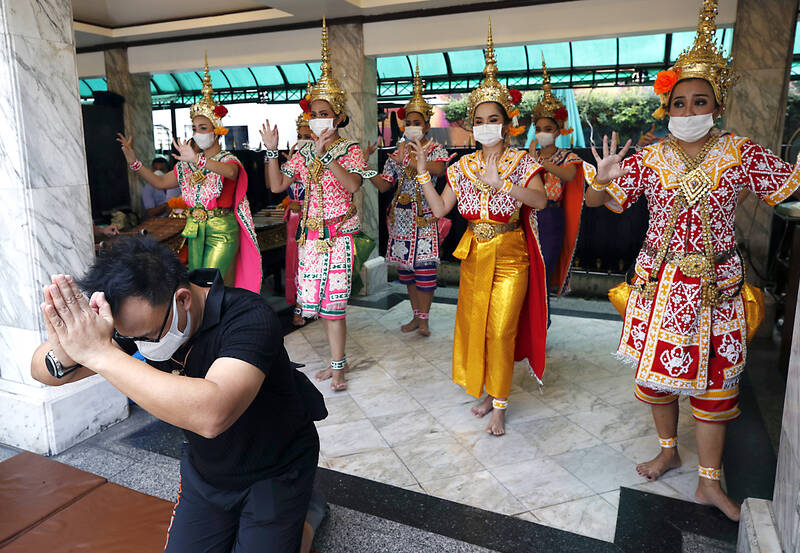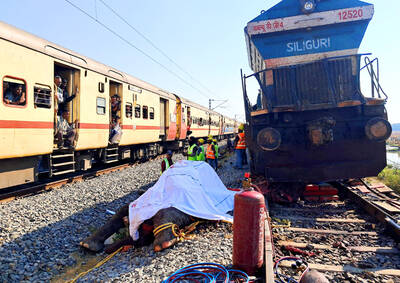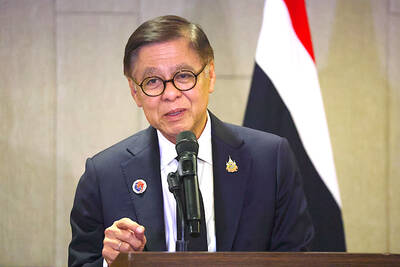Southeast Asia’s tourist economies are set to be the leading beneficiaries of China’s scrapping of travel bans as they have steered clear of the COVID-19 pre-entry tests that the US, Japan and many European countries have imposed on Chinese visitors.
Such newly mobile Chinese tourists are likely to opt for “minimal hassle” and head for destinations that do not require testing, which in turn stands to benefit Southeast Asia, CIMB Private Banking economist Song Seng Wun (宋城煥) said.
“The busier regional airports are, the better it is for their economies,” he said.

Photo: EPA-EFE
Southeast Asian countries — including Cambodia, Indonesia and Singapore — have not mandated COVID-19 testing for arrivals from China.
“We are not taking the stance of discriminating [against] any countries,” Malaysian Prime Minister Anwar Ibrahim said.
Officials have downplayed health worries aired by other countries.
Singapore said it has a high population immunity, as about 40 percent of its people have been infected with COVID-19 and 83 percent have been vaccinated, while it has bolstered healthcare capacity.
Hong Kong University public health professor Karen Grepin agreed with that approach.
“Every day, countries import thousands of cases of COVID-19 from around the world,” she said.
Bali Tourism Board chairman Ida Bagus Agung Partha said the popular resort island would “increase our defense,” as workers are offered a second booster dose of a COVID-19 vaccine this month.
Cambodian Prime Minister Hun Sen described other countries’ testing requirements as “propaganda” designed to “scare people.”
Meanwhile, many businesses in Japan and South Korea welcome the return of Chinese tourists.
In Tokyo’s Asakusa tourist district, caricaturist Masashi Higashitani has been practicing his Mandarin in preparation for an influx of travelers.
“We used to say ‘ni hao’ all the time,” he said with a laugh as he whipped up a portrait in minutes.
Nearly 9.6 million Chinese visited Japan in 2019, the biggest group of foreign tourists by far, and a massive leap from the 450,000 who went in 2003.
Higashitani estimated that about 20 percent of his customers were from China before the COVID-19 pandemic, and he and his employees picked up Chinese phrases from those visitors and each other.
He had to downsize and let staff go during the pandemic, so he is thrilled about the expected wave of arrivals, although he admits to some apprehension.
“I wonder if an influx of too many of them might overwhelm our capacity. I’m also worried that we need to be more careful about anti-virus measures,” he said.
Travelers arriving back in China starting tomorrow no longer need to quarantine, removing one of the main barriers to Chinese traveling abroad.
The announcement sparked a frenzy of trip planning, with online searches spiking for Thailand, Japan, South Korea, Macau and Hong Kong.
Chinese tourists made up about one-third of all pre-pandemic foreign visitors to South Korea.
At a crepe stand in Seoul, Son Kyung-rak said he was making plans to deal with a flood of tourists from China.
“We’re looking to hire and preparing to stock up,” the 24-year-old said in Seoul’s popular Myeongdong district. “Chinese tourists are our main customers, so the more the merrier.”
However, authorities in Seoul are more cautious.
The slump in Chinese visitors “has been a blow to our tourism industry,” South Korean Ministry of Culture, Sports and Tourism official Yun Ji-suk said. “But now is not the time to be active in tourism marketing, due to the ongoing COVID situation.”
Additional reporting by AFP

REVENGE: Trump said he had the support of the Syrian government for the strikes, which took place in response to an Islamic State attack on US soldiers last week The US launched large-scale airstrikes on more than 70 targets across Syria, the Pentagon said on Friday, fulfilling US President Donald Trump’s vow to strike back after the killing of two US soldiers. “This is not the beginning of a war — it is a declaration of vengeance,” US Secretary of Defense Pete Hegseth wrote on social media. “Today, we hunted and we killed our enemies. Lots of them. And we will continue.” The US Central Command said that fighter jets, attack helicopters and artillery targeted ISIS infrastructure and weapon sites. “All terrorists who are evil enough to attack Americans are hereby warned

‘POLITICAL LOYALTY’: The move breaks with decades of precedent among US administrations, which have tended to leave career ambassadors in their posts US President Donald Trump’s administration has ordered dozens of US ambassadors to step down, people familiar with the matter said, a precedent-breaking recall that would leave embassies abroad without US Senate-confirmed leadership. The envoys, career diplomats who were almost all named to their jobs under former US president Joe Biden, were told over the phone in the past few days they needed to depart in the next few weeks, the people said. They would not be fired, but finding new roles would be a challenge given that many are far along in their careers and opportunities for senior diplomats can

Seven wild Asiatic elephants were killed and a calf was injured when a high-speed passenger train collided with a herd crossing the tracks in India’s northeastern state of Assam early yesterday, local authorities said. The train driver spotted the herd of about 100 elephants and used the emergency brakes, but the train still hit some of the animals, Indian Railways spokesman Kapinjal Kishore Sharma told reporters. Five train coaches and the engine derailed following the impact, but there were no human casualties, Sharma said. Veterinarians carried out autopsies on the dead elephants, which were to be buried later in the day. The accident site

RUSHED: The US pushed for the October deal to be ready for a ceremony with Trump, but sometimes it takes time to create an agreement that can hold, a Thai official said Defense officials from Thailand and Cambodia are to meet tomorrow to discuss the possibility of resuming a ceasefire between the two countries, Thailand’s top diplomat said yesterday, as border fighting entered a third week. A ceasefire agreement in October was rushed to ensure it could be witnessed by US President Donald Trump and lacked sufficient details to ensure the deal to end the armed conflict would hold, Thai Minister of Foreign Affairs Sihasak Phuangketkeow said after an ASEAN foreign ministers’ meeting in Kuala Lumpur. The two countries agreed to hold talks using their General Border Committee, an established bilateral mechanism, with Thailand